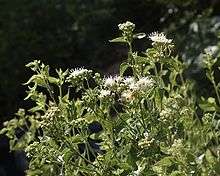Ageratina herbacea
Ageratina herbacea is a North American species of flowering plants in the daisy family known by the common names fragrant snakeroot and Apache snakeroot.[2] It is native to desert regions (Sonoran, Mojave, and Chihuahuan Deserts) of the southwestern United States (southeastern California, southern Nevada, southern Utah, Colorado, Arizona, New Mexico, western Texas) and northern Mexico (Baja California, Chihuahua, Coahuila, Sonora). It grows in rocky slopes in conifer forests and woodlands.[3][4][5][6]
| Ageratina herbacea | |
|---|---|
 | |
| Scientific classification | |
| Kingdom: | Plantae |
| Clade: | Tracheophytes |
| Clade: | Angiosperms |
| Clade: | Eudicots |
| Clade: | Asterids |
| Order: | Asterales |
| Family: | Asteraceae |
| Genus: | Ageratina |
| Species: | A. herbacea |
| Binomial name | |
| Ageratina herbacea | |
| Synonyms[1] | |
|
Synonymy
| |

Ageratina herbacea is a perennial herb growing a green, fuzzy stem from a woody caudex to heights between about 50 and 70 centimeters. The leaves are yellow to green or grayish and are triangular to heart-shaped. The inflorescence is a cluster of fuzzy flower heads under a centimeter long containing long, protruding white disc florets and no ray florets. The fruit is an achene a few millimeters long with a rough bristly pappus.[7]
Etymology
Ageratina is derived from Greek meaning 'un-aging', in reference to the flowers keeping their color for a long time. This name was used by Dioscorides for a number of different plants.[8]
References
- "Ageratina herbacea (A.Gray) R.M.King & H.Rob.". The Global Compositae Checklist (GCC) – via The Plant List.
- "Ageratina herbacea". Natural Resources Conservation Service PLANTS Database. USDA.
- Nesom, Guy L. (2006). "Ageratina herbacea". In Flora of North America Editorial Committee (ed.). Flora of North America North of Mexico (FNA). 21. New York and Oxford – via eFloras.org, Missouri Botanical Garden, St. Louis, MO & Harvard University Herbaria, Cambridge, MA.
- "Ageratina herbacea". County-level distribution map from the North American Plant Atlas (NAPA). Biota of North America Program (BONAP). 2014.
- "Ageratina herbacea". Calflora: Information on California plants for education, research and conservation, with data contributed by public and private institutions and individuals, including the Consortium of California Herbaria. Berkeley, California: The Calflora Database – via www.calflora.org.
- Turner, B. L. 1997. The Comps of Mexico: A systematic account of the family Asteraceae, vol. 1 – Eupatorieae. Phytologia Memoirs 11: i–iv, 1–272
- Hickman, James C., ed. (1993). "Ageratina herbacea". The Jepson Manual: Higher Plants of California. University and Jepson Herbaria.
- Gledhill, David (2008). "The Names of Plants". Cambridge University Press. ISBN 9780521866453 (hardback), ISBN 9780521685535 (paperback). pp 39
External links
Ageratina herbacea in the CalPhotos Photo Database, University of California, Berkeley